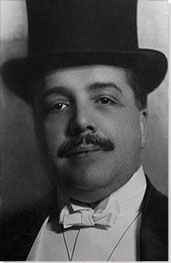Summary of Sergei Diaghilev
Sergei Diaghilev took early 20th century Europe by storm with his modern dance company, the Ballet Russes. The company rapidly became known, not just for their ballet, but also for their sets and costumes and the impact of Diaghilev's artistic vision can still be felt today in both the art and dance worlds. Charming, ruthless, and powerful, Diaghilev identified and nurtured talent across a range of genres from design to composition and choreography, bringing household names such as Stravinsky to prominence and launching the careers of a number of highly influential dancers. He also worked with more established artists and designers including Coco Chanel, Pablo Picasso, Joan Miró, and André Derain giving them an outlet for new ideas. In doing so, he ensured that the Ballet Russes remained at the forefront of the avant-garde for two decades through a turbulent period of history.
Accomplishments
- Building on 19th century trends in Orientalism, Diaghilev's early productions were steeped in the romanticized idea of the exotic East and through their plots, costumes and set designs (many of latter were designed by artist Leon Bakst), the company exported a fantasy of Russia to Europe which is still referenced today. Their shows, particularly Scheherazade (1910), also sparked fashions for 'eastern' styles, opulent colors, and rich fabrics in both clothing and interior design.
- Throughout all his productions, Diaghilev ensured a close and seamless integration of music, plot choreography, and design to create a complete work of art (or Gesamtkunstwerk) which was greater than the sum of its parts. This was the first time that this concept had been applied to dance and the resulting ballets were known for their overall spectacle and experience.
- Diaghilev was openly gay, having passionate and tumultuous affairs with several of his lead dancers, and although this alienated more conservative factions it also won him patrons and supporters in some well-connected and aristocratic circles. As composer Nicolas Nabokov noted, "he was perhaps the first grand homosexual who asserted himself and was accepted as such by society".
The Life of Sergei Diaghilev
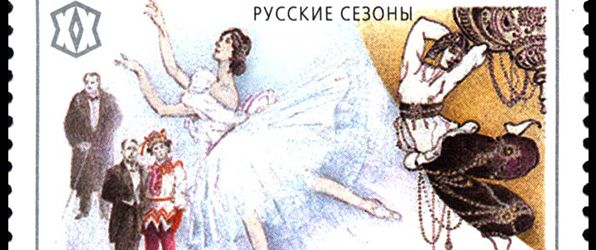
Diaghilev's is a life of a legendary figure. This stamp symbolically shows the figure of the impressario in the background, with a commemoration of his achievements in the foregroud.
Sergei Diaghilev and Important Artists and Artworks
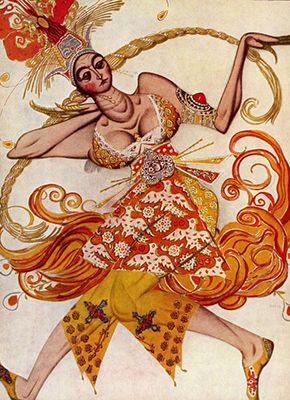
Costume design for The Firebird (1910)
The plot of The Firebird follows Ivan Czarevitch (initially danced by Mikhail Fokine) as he attempts to free the imprisoned Firebird (danced by Tamara Karsavina) from the hidden garden of the evil Koshchei. The settings and costumes were designed by Aleksandr Golovine, except for the three main characters, including this design for the eponymous Firebird, which were created by Diaghilev's World of Art companion Léon Bakst. In this sketch for the costume design, the headpiece and main part of the dress consist of feathers, which, when paired with loose and semi-transparent orange trousers, created a magical flying effect when Karsavina danced across the stage. The bright use of colors associated with fire - orange, yellow and red - added a dynamism and energy to the performance. Bakst furthered this mythical hybrid of bird and woman through the use of exotic and oriental patterns and embellishments to the costume.
The subject matter, music and style of The Firebird demonstrates the eclecticism of the World of Art movement. Stravinsky's music, teamed with Fokine's mix of classical and freer interpretive styles of dance, created a total work of art with the aim of transporting Western audiences to a magical Russia. When the performance debuted at the Paris Opéra on June 25th 1910, it was instantly acclaimed by the critics for its dancing and design, but also for this symbiosis. Writing in Nouvelle Revue Française in 1910, the critic Henri Ghéon enthused that the visuals "seem to have been invented to a formula identical with that of the shimmering web of the orchestra". The success of Bakst's costumes cemented his position and a key figure in the Ballets Russes for years to come.
Watercolor on paper - Béarn Collection, Paris, France
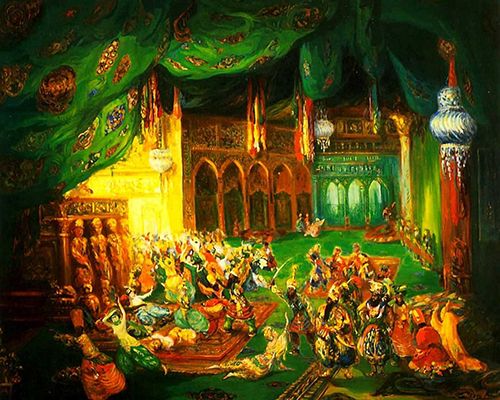
Sketch of the scenery for Schéhérazade (1910)
After the success of the first season of the Ballets Russes, Bakst designed the set and costumes for the ballet Schéhérazade in 1910, composed by Rimsky-Korsakov and choreographed by Fokine. Based on a collection of Middle Eastern folk tales, the ballet combined Eastern exoticism and Russian designs. Bakst used bright colors, such as red and green, and luxurious golds to depict the sumptuous palace interiors. Architectural features, including intricate archways and domes, called on Eastern traditions but also the architecture of Russian orthodox churches. Bakst was not concerned with an ethnographically correct representation of the East, but rather the creation of a visual fantasy based on romantic ideas of the region, tapping into a long-held fascination by Western audiences.
Diaghilev was so thrilled with Bakst's designs for Schéhérazade, that shortly after the first performance he hailed him the "hero of our ballet". Alexandre Benois mirrored this praise, describing the décor as "a world of special sensations". Sketches of the designs for Schéhérazade were immediately purchased by the Musée des Arts Décoratifs in Paris: a tribute to their profound cultural impact. Bakst was interviewed by fashion magazines and then approached by Parisian women to design dresses for them. Couture houses used the cuts of the costumes for their latest designs, and skirts resembling oriental trousers soon became fashionable across Europe. Cocteau remarked that the ballet single-handedly "splashed all Paris with colors". This was seen not only in clothing but also in the interior design of middle-class homes: the vivid greens used in the stage sets were now available to purchase in cushions and carpets.
Oil on canvas - Collection of Nikita and Nina Lobanov-Rostovsky, London
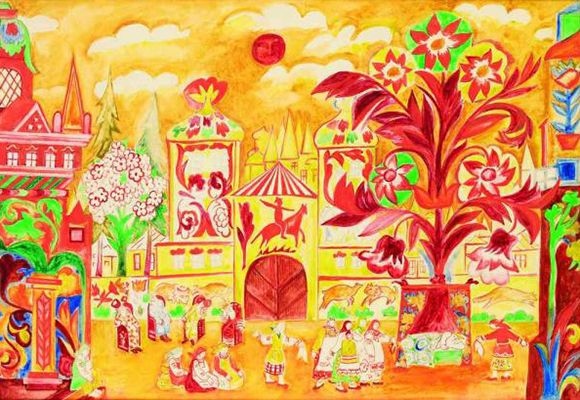
Sketch of the scenery for Le Coq d'Or (1914)
Composed by Rimsky-Korsakov and choreographed by Fokine, Le Coq d'Or opened at the Paris Opéra in May 1914. The scenery, produced by the Russian avant-garde artist Natalia Goncharova, marked a departure from Diaghilev's usual choice of designer. Goncharova employed elements of older Russian art, such as popular prints called lubki, which used simple images to relay stories. Using bold graphic forms and colors, the artist created a new trend in painting. She employed lively color combinations of red, orange and yellow, inspired by the folk art of her homeland, and loaded with symbolic content. Such was the effect that Benois noted that "Goncharova has conquered Paris with her brightly multi-colored settings".
Goncharova's interpretation of the Russian tradition differed from that of the World of Art movement as her approach was more abstract and progressive. She viewed older art not just as something to admire, but as something that had contemporary relevance. Diaghilev's decision to commission Goncharova, therefore, marked a new aesthetic for the Ballets Russes as he was beginning to find the art of Benois and Bakst outdated. He travelled to Moscow to visit Goncharova in her studio after hearing about her work at the forefront of the Russian avant-garde. Impressed by what he saw, Diaghilev recognized that her work matched his own artistic aims: to use ideas from the past, particularly their shared fascination with the Russian-Oriental, to create something entirely new in the present. Such was his confidence in Goncharova, that he let her design the sets without ever seeing them. Le Coq d'Or became the only real hit of the Ballets Russes's 1914 season.
Watercolor, gouache and pencil on paper - Private Collection
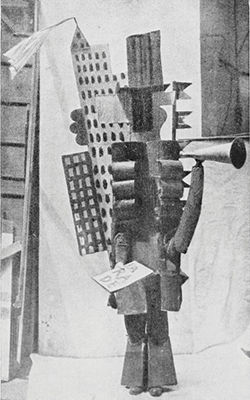
Costume design for Parade (1917)
Picasso had never seen a ballet when he was asked by Diaghilev and the writer Jean Cocteau to collaborate on the Ballets Russes's upcoming production Parade. The ballet was based on a one-act scenario by Cocteau, with choreography by Léonide Massine and music by Erik Satie. Picasso accepted the comission to design the sets and costumes, believing that it could launch his avant-garde art in a new forum. The plot was based on a Parisian music-hall with three groups of circus artists positioned outisde a vaudeville theater attempting to lure in passersbys to watch their show.
Picasso's designs were strikingly modern, taking formal cues from American skyscrapers and boulevards and inspiration from the flamboyant colors of the vaudeville halls he frequented. He employed his Cubist style to create the impression of building blocks with odd angles and uneven perspective: a three-dimensional representation of his paintings of the time. However, Picasso's naivety in costume designed was revealed in his choice of cardboard as the material, which only allowed the dancers minimal movements. The outfits were described by a London critic as "craziness with a touch of genius".
Diaghilev saw obtaining Picasso as a designer as a major achievement in his objective to keep the Ballets Russes fresh and innovative. By 1917 Diaghilev had begun to hire non-Russian composers and artists in his productions in an attempt to be on the cutting edge of the avant-garde; only his choreographers remained Russian until the company's end. When Parade premiered at the Théâtre du Châtelet amid the First World War in May 1917, it received bad reviews. The audience were so incensed at the use of machine-gun noises and Picasso's unconventional designs, instead expecting a patriotic programme, that they began to shout "down with foreigners". Diaghilev took the decision to cancel the ballet after two days. However, he revisited it in 1920, to better reviews, prompting him to describe the work as "my best bottle of wine. I do not like to open it too often". Despite criticism, Parade marked Diaghilev's least-Russian ballet to date and a shift in his directorship to a more international company. It changed the perception of the Ballets Russes with its originality and modern subject matter and designs. For the first time, European modernism was on the stage and in the awareness of mainstream culture. The poet Guillaume Apollinaire, who wrote the programme notes for Parade when it debuted in 1917, described Picasso's designs as "a kind of surrealism", laying claim to this term three years before the Surrealism movement fully emerged in Paris.
Cardboard
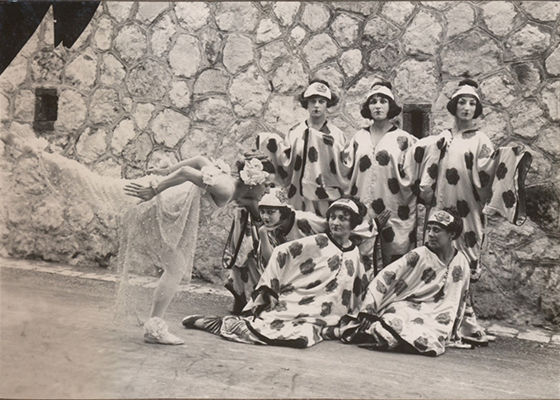
Photograph of the costumes for Le Chant du Rossignol (1920)
Le Chant du Rossignol was written by Stravinsky, based on a Hans Christian Andersen tale, and choreographed by Massine. In typical Ballets Russes style, it incorporated a strong Eastern theme, based around a nightingale who sings and dances for the Emperor of China. Veering away from the sumptuous productions the company had stage before the First World War, Matisse saw the work as a tale about renewal and focused on "spring-like, very fresh and youthful" designs. He used simple shapes and light hues against a white backdrop, basing the costumes on traditional Chinese patterns. Instead of the deep colors and thick materials used previously, the artist opted for silk with delicate print and embroidery. For the chorus costumes, as seen here, Matisse took care in creating the impression of a single pattern, inspired by Chinese scroll painting.
Diaghilev used all his infamous charm to convince Matisse to design the sets and costumes for Le Chant du Rossignol. He wrote to Matisse, declaring "it's absolutely essential you do it...there's no one but you who could". The ballet was part of a season for which Diaghilev had already secured Picasso and Derain as designers, and Matisse was hesitant to be entered into comparison with such rival artists. However, after much chasing he was persuaded, but continued to dislike Diaghilev's manner and approach.
The production premiered on February 2nd 1920 at the Théâtre National de l'Opéra in Paris to positive reviews, although the critics found it to be tame compared to Stravinsky's ground-breaking pre-war compositions. Despite this, it was restaged in 1925, with different choreography by George Balanchine. Matisse, however, unlike his rival Picasso, did not collaborate with Diaghilev again.
Mixed media - Library of Congress
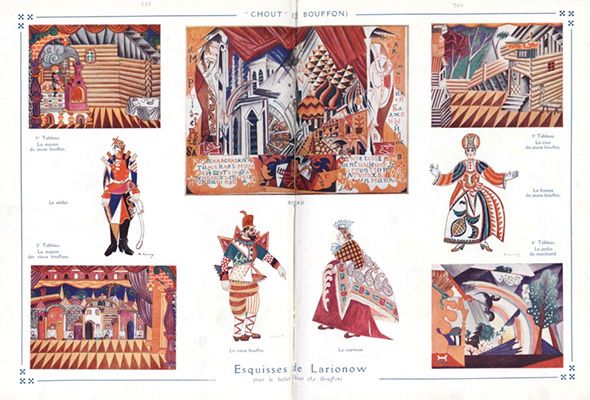
Sketches for the costumes and set designs of Chout, featured in the official program (1921)
Chout was a ballet based on a Russian folk tale, suggested to Diaghilev by Stravinsky. In the tale, seven buffoons murder their wives after being told by an eighth buffoon that he has the magic to bring people back to life. When the eighth buffoon fails and the others seek revenge, he disguises himself as a woman to escape. Such a tale suited the art of Larionov, who (along with Goncharova) looked to the Russian past in his use of form and color. Diaghilev and Larionov had a long history of collaboration as Diaghilev had featured the artist in two of his exhibitions of 1906, in St Petersburg's Catherine Hall and again in the Paris Salon d'Automne.
In his set designs, Larionov created fairytale-like worlds through the use of Futurist and Primitivist ideas, such as bold graphics, stripes and triangles. The costumes mirrored the décor in their use of pattern, derived from traditional rural Russian dress. Again, Diaghilev sought to use an artist from his homeland to promote the unique and fascinating style of Russia and the East. After the ballet's premiere in May 1921 at the Théâtre Municipal de la Gaîté in Paris, one critic described Larionov's sets as being like the famous 19th-century Russian artist's colony Abstramtsevo, only "after an earthquake". Larionov's work did not, however, suit all tastes, and when the ballet debuted in London, the dance critic Cyril Beaumont said "the color contrasts were so vivid and dazzling that it was almost painful to look at the stage".
Chout was one of the hardest ballet's Diaghilev had ever produced, and he relied heavily on his old acquaintance Larionov not just in the set and costume design, but also in the choreography. At the time, French critics were speculating that Diaghilev had lost his ability to identify cutting-edge artists and creatives. Diaghilev hoped that his first commission from Sergei Prokofiev for the ballet's score and his employment of the young Polish dancer Tadeusz Slavinsky to choreograph would silence the critics. However, from the rehearsals it was clear that Slavinsky found the complex music too difficult, so Diaghilev turned to Larionov for help; an odd choice given the artist's lack of musical skills. Prokofiev found Larionov's designs and creative input helpful, stating "he did everything I wanted, and I relied on his huge resourcefulness and good taste".
Watercolor on paper - Bibliothèque nationale de France
Biography of Sergei Diaghilev
Childhood
Diaghilev was born in Selishchev Barracks, a military community in the western Russian province of Novgorod. His father, Pavel Pavlovich, was a military officer, whose family had made their money from vodka distilleries. Following the death of his wife whilst his son was still an infant, Pavel married Elena Valerianovna Panaeva, an artistic woman and amateur singer. Elena introduced Diaghilev to the world of music and instructed his early education, encouraging in him a love of the arts. Throughout his life Diaghilev remained close to his stepmother, continuing to write to her until her death in 1919. The family moved from the military Barracks to Perm, and then to an apartment in St Petersburg in the 1880s.
Childhood and Education
In 1890, Diaghilev finished school and embarked on a tour of Western Europe, taking in the cultural sights and museums of cities such as Paris, Venice, and Rome, all of which he would return to later in life. Afterwards, Diaghilev moved to St Petersburg to study law, but also took classes at the St Petersburg Conservatory of Music in his spare time, hoping to become a composer. By 1892, however, he had abandoned this dream, as his professor Nikolai Rimsky-Korsakov, told him he had no talent for music.
Whilst at university, Diaghilev joined a circle of intellectual art-lovers who called themselves the Nevsky Pickwickians. Amongst the group were the artists Alexandre Benois and Léon Bakst, and the writers Dmitry Filosofov (who was also Diaghilev's cousin) and Walter Nouvel. The group were joined by their love of the arts and their frustration with how critics wrote about art at the time. There were two main types of criticism: a patriotic, traditionally academic genre versus a more revolutionary type of critic, who called for all art to be socially relevant. The Nevsky Pickwickians saw both of these approaches as limiting and instead drew attention to largely overlooked areas of art, such as Russian icons, church frescoes, Romantic painters of the previous centuries, and Western art such as the Pre-Raphaelites in England. It was this renewal of the Russian past, teamed with new discoveries in Western art, which informed Diaghilev's ever-evolving tastes during the 1890s.
In 1898, the Nevsky Pickwickians founded a journal called Mir Iskusstva (World of Art), with financial backing from the arts patron Princess Maria Tenisheva and the merchant Savva Mamontov. From the moment the journal was published, critics on both the political left and right sought to discredit its ideas. The traditionalist art critic Vladimir Stasov described the works featured in the journal, including those by Edgar Degas, Claude Monet, and Bakst, as "the work of a three-year-old child holding a pencil for the first time". From the other side, the critic Viktor Burenin, writing in the revolutionary newspaper New Times, attacked Diaghilev personally: "the pretensions of a Mr. Diaghilev who edits this journal are not only astounding but also extraordinarily stupid". The negative criticism did not stop Diaghilev and the World of Art movement. He continued to publish critical art pieces, and in 1897 organized an exhibition in St Petersburg showcasing the type of art the group championed.
By 1899, Diaghilev had secured a job working for Prince Sergei Mikhaylovich Volkonsky, the director of the Imperial Theaters. Diaghilev was responsible for the production of the Theaters' annual showcase in 1900, a role which fully immersed him in the theatrical world for the first time. Following this, he was tasked with staging Léo Delibes' ballet Sylvia. He chose his friend Alexandre Benois to work with on the design, but their ideas shocked the Theater. Refusing to change his artistic vision, Diaghilev was fired by Volkonsky shortly after.
Mature Period
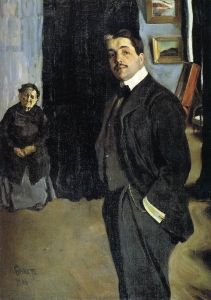
After this incident, Diaghilev returned to organizing art exhibitions and in 1905, he staged an exhibition of Russian painting at the Tauride Palace in St Petersburg. To prepare for this, Diaghilev travelled throughout Russia collecting Russian artists of the past and present and in doing so collated a huge number of works by fine art painters of the 19th century who had been largely ignored or forgotten. The next year, he expanded his ambitions and took an exhibition of Russian art, from icons to modernist works, to the Petit Palais in Paris, and subsequently toured the exhibition to Berlin and Venice.
Encouraged by the warm reception he had received for Russian art in Paris, Diaghilev returned to his love of music. In 1907 he staged five concerts of Russian music in Paris, with appearances by his former mentor Rimsky-Korsakov, as well as Rachmaninoff and Scriabin. The following year, he presented Mussorgsky's Boris Godunov at the Paris Opéra which garnered glowing reviews.
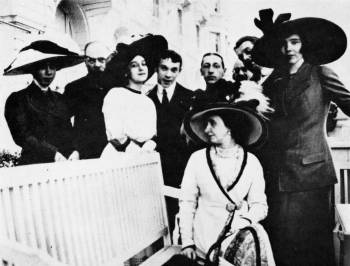
Bolstered by the success of his productions in Paris, Diaghilev founded the Ballets Russes in 1909. He appointed Mikhail Fokine as chief choreographer, who, despite his traditional training at the Imperial Ballet School in St Petersburg, was an avant-gardist who sought to blend ballet with modern dance. The young Vaslav Nijinsky, who was also Imperial Ballet School trained, was cast as the company's prime male dancer. Diaghilev and Nijinsky later became embroiled in a tumultuous love affair, and Diaghilev continued to be involved in developing Nijinsky's career with the company. Diaghilev's World of Art companion Léon Bakst took the role of artistic director and he designed many of the costumes. Both he and Daighilev shared the aim of creating a total work of art (a concept known as Gesamtkunstwerk) through the seamless combination of performance, music and set, and costume design. Given the enthusiasm for Russian art and music shown by French audiences, Bakst and Diaghilev added an unapologetically Russian style to the Ballets Russes' productions. The designs were visually stimulating, bringing in the color and exoticism of the Russian east combined with the Art Nouveau fashions of the West. This dynamic and innovative approach resulted in an opening night sensation. The French writer Jean Cocteau said the performances "shook France".
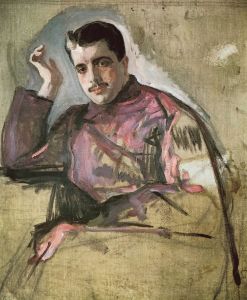
The Ballets Russes quickly became in demand across Europe and Diaghilev established them as a year-round touring operation in 1911. The success enjoyed during this period was seen by Diaghilev and Bakst as a long-awaited justification of the World of Art group's ideas of the 1890s. As the driving force behind the company, Diaghilev became inextricably linked with it. He quickly developed a reputation as a hard taskmaster, demanding only the best from his dancers and inspiring fear and respect in those who worked for the company. The composer Erik Satie described Diaghilev as "an amiable sort, but an awful person".
As the company went from strength-to-strength, Diaghilev commissioned ballet music from composers including Claude Debussy (Jeux, 1913), Maurice Ravel (Daphnis et Chloé, 1912), Richard Strauss (Josephslegende, 1914), and Erik Satie (Parade, 1917). His most notable collaborator, however, was the relatively unknown Russian composer Igor Stravinsky. At the age of 28, Stravinsky had previously composed music for Diaghilev and had impressed him with his ability to deliver scores at short notice. Diaghilev commissioned a full score for The Firebird, which, following its première at the Paris Opéra in June 1910, was met with immediate acclaim. Following this success, Diaghilev was quick to commission more from Stravinsky, resulting in Petrushka in 1911 and The Rite of Spring in 1913. Diaghilev's unfaltering support for talent from his homeland was also seen in his commissioning of up-and-coming Russian modernist artists. For example, from 1914, his principal set designers included the avant-garde artist Natalia Goncharova who, like the World of Art group, looked to older Russian art for new inspirations.
By 1912, Nijinsky was choregraphing ballets for the company, including Debussy's L'après-midi d'un faune and Stravinsky's Le Sacre du Printemps. However, following Nijinsky's sudden marriage to the Hungarian aristocrat Romola de Pulszky whilst on tour with the company in South America in 1913, the dancer was promptly dismissed by Diaghilev. This decision was certainly in part motivated by Diaghilev's personal feelings for Nijinsky, but it was also common practice for dancers to leave the Ballets Russes when they got married. Nijinsky did appear again with the company in the 1920s, but his relationship with Diaghilev was never the same following his 'betrayal'.
Following Nijinsky's fall from grace, Diaghilev returned to Moscow to scout a replacement for his role in the upcoming performance of Strauss's Josephslegende. Diaghilev chose the nineteen-year-old Léonide Massine, a recent graduate from the Moscow Imperial Theater School. Like Nijinsky, Massine was soon starring in the main male roles for the Ballets Russes and went on to choreograph many of their major post-war productions. He also replaced Nijinsky as Diaghilev's lover.
Late Period
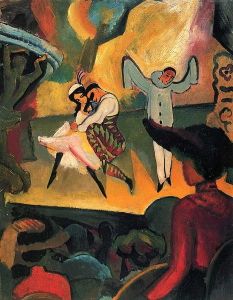
The First World War meant the Ballets Russes had to adapt quickly to very different circumstances. Economic hardship spread across Europe and pastimes such as going to the ballet were deemed by many as frivolous and luxurious. Diaghilev faced the challenge of depleted audiences with flexibility, taking the company on a tour of North America for several years from 1915.
The events of 1917 proved even trickier for Diaghilev and his contemporaries to react to. The Russian revolution in February 1917 was initially welcomed by the World of Art group, signaling a new and free society and the fresh approach to art that they had long advocated. To celebrate, Diaghilev had dancers carry a red flag in the finale of that year's production of The Firebird. However, the subsequent revolution of October 1917 and resulting Bolshevik regime, overseen by Lenin, resulted in a dramatic change of outlook for the World of Art group. Diaghilev was cast by the new regime as an example of bourgeois excess and he, along with many other members of the artistic community, left Russia permanently in 1918.
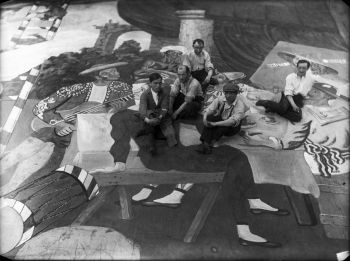
This political turmoil was mirrored in Diaghilev's own life. His relationship with dancer Massine was unstable, and he had no way of finding out whether his friends and family in Russia were safe. It was perhaps this private upheaval and the rejection by his homeland that led Diaghilev to increasingly commission Western European artists to design sets and costumes for the Ballets Russes productions of the late 1910s and 1920s.
Following the Russian Revolution and the First World War, Diaghilev became increasingly ruthless with the company as he worked to reinvigorate it with a fresh artistic vision. In 1919, Bakst completed the designs for the production of Le Boutique Fantasque. Unhappy with the first drafts, Diaghilev commissioned the rising French Fauvist André Derain to redo them. Diaghilev and Derain had known each other since Diaghilev's exhibition of Russian art at the Salon d'Automne in 1906, and Derain had long expressed an interest in working with the Ballet Russes. Diaghilev neglected to inform Bakst that there were now two artists working on the same project. The eventual fallout resulted in an unrecoverable blow to their friendship, as Massine noted "the artistic perfection of his production was the most important thing in his life and he would allow nothing, not even a longstanding friendship, to stand in the way of it".
Diaghilev was not afraid to aggressively recruit some of the biggest artists of the day. To convince Matisse to design the sets and costumes for Le Chant du Rossignol, Diaghilev, along with Stravinsky, arrived unannounced at the artist's home just outside Paris, even though his rival Picasso was designing for a different production that season. Matisse later compared Diaghilev to Louis XIV: "he's charming and maddening at the same time - he's a real snake - he slips through your fingers - at bottom the only thing that counts is himself and his affairs".
In 1921, Diaghilev staged a production of Tchaikovsky's The Sleeping Beauty in London, which was well received but a failure financially. Although the Ballets Russes continued to perform throughout the 1920s, they were increasingly considered as too stylized and not as avant-garde as they once were. In his later years, as well as continuing to lead the Ballets Russes, Diaghilev became an avid collector of rare books and manuscripts. Much of his collection has now been acquired by various university libraries. Diaghilev died from diabetes in Venice in 1929 and was buried on the nearby island of San Michele.
The Legacy of Sergei Diaghilev
Although throughout his life Diaghilev created a difficult reputation for himself, he was lauded by his contemporaries as a key figure in bringing Russian art and music to the West. The fashion designer Coco Chanel who costumed Diaghilev's ballet Le Train Bleu in 1924, stated that "Diaghilev invented Russia for foreigners".
In his commissions from rising musical composers, Diaghilev helped shape the musical landscape of the 20th century. By championing such experimental composers as Stravinsky, Diaghilev aided the development of new tonality and rhythm, freeing up traditional concepts of ballet music. Without Diaghilev's support, such composers would not have written some of the major musical masterpieces of that century. This brought music and ballet to a wider audience and reestablished the popularity of ballet as a major art form.
Diaghilev's harsh but nurturing encouragement of young dancing talent and his willingness to allow dancers to also work as choreographers changed the face of modern dance. Tamara Karsavina, one of the Ballets Russes' troupe, who later emigrated to London and was a founding member of the Royal Academy of Dance, noted that "many are the names which Diaghilev wrote, with his own hand, in the book of fame". Many of the dancers and choreographers involved in the Ballets Russes went on to found important dance schools in North America, such as George Balanchine and Ruth Page, and in England, such as Marie Rambert and Ninette de Valois.
Similarly, his decision to commission avant-garde artists to create the Ballets Russes' sets and costumes had huge repercussions across Europe. Diaghilev revealed to the West the importance of Russian art; both traditional and radical. The use of color and Eastern influences revolutionized the aesthetics of early 20th-century design, theater, and fashion. The modern Cubist costumes featured in productions such as Parade can be seen as a direct precursor to later experimental theater designs. Oskar Schlemmer's teachings at the Bauhaus borrowed heavily from the geometric designs of Picasso as commissioned by Diaghilev.
The designs also had an impact on the Paris fashion houses and particularly on the work of designer Paul Poiret. In the wake of the Ballet Russes' production of Scheherazade (1910), Poiret produced collections of clothing which espoused an opulent Orientalist aesthetic and included bright colors, sumptuous fabrics, and items such as turbans and harem pants. His work went on the influence both mainstream fashion and interior design. More recently, Yves Saint Laurent's 1976 haute couture collection, belle Russe, paid homage the costumes of the Ballet Russes.
Diaghilev was also key in changing Russian cultural attitudes. This can be seen in the World of Art journal, which, although only surviving five years, informed readers about art of the Russian past and present. In doing so, it departed from the academic traditions or revolutionary beliefs of the prevailing critical landscape. As the Russian historian Simon Karlinsky describes, Diaghilev was a "cultural educator of genius". Despite not being a creator himself, Diaghilev was the instigator of many of the major cross-cultural creative moments of the early 20th century.
Influences and Connections

- Russian icon painters
- Russian church fresco painters
- Dmitry Filosofov
- Walter Nouvel
- Princess Maria Tenisheva
- Savva Mamontov
-
![The Pre-Raphaelites]() The Pre-Raphaelites
The Pre-Raphaelites - World of Art
- Medieval Russian painters
-
![Pablo Picasso]() Pablo Picasso
Pablo Picasso -
![Henri Matisse]() Henri Matisse
Henri Matisse -
![Juan Gris]() Juan Gris
Juan Gris -
![André Derain]() André Derain
André Derain ![Leon Bakst]() Leon Bakst
Leon Bakst
-
![Jean Cocteau]() Jean Cocteau
Jean Cocteau ![Igor Stravinsky]() Igor Stravinsky
Igor Stravinsky![Erik Satie]() Erik Satie
Erik Satie- Claude Debussy
Useful Resources on Sergei Diaghilev
- Diaghilev: A LifeOur PickBy Sjeng Scheijen
- Diaghilev and FriendsOur PickBy Joy Melville
- Diaghilev: Creator of the Ballets RussesBy Ann Kodicek
- Diaghilev and the Ballets Russes 1909-1929By Jane Pritchard and Geoffrey Marsh
- Freedom from Violence and Lies: Essays on Russian Poetry and MusicBy Robert P. Hughes, Richard Taruskin, Thomas A. Koster
 Ask The Art Story AI
Ask The Art Story AI